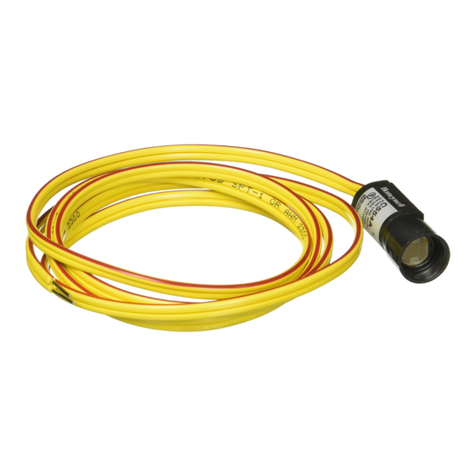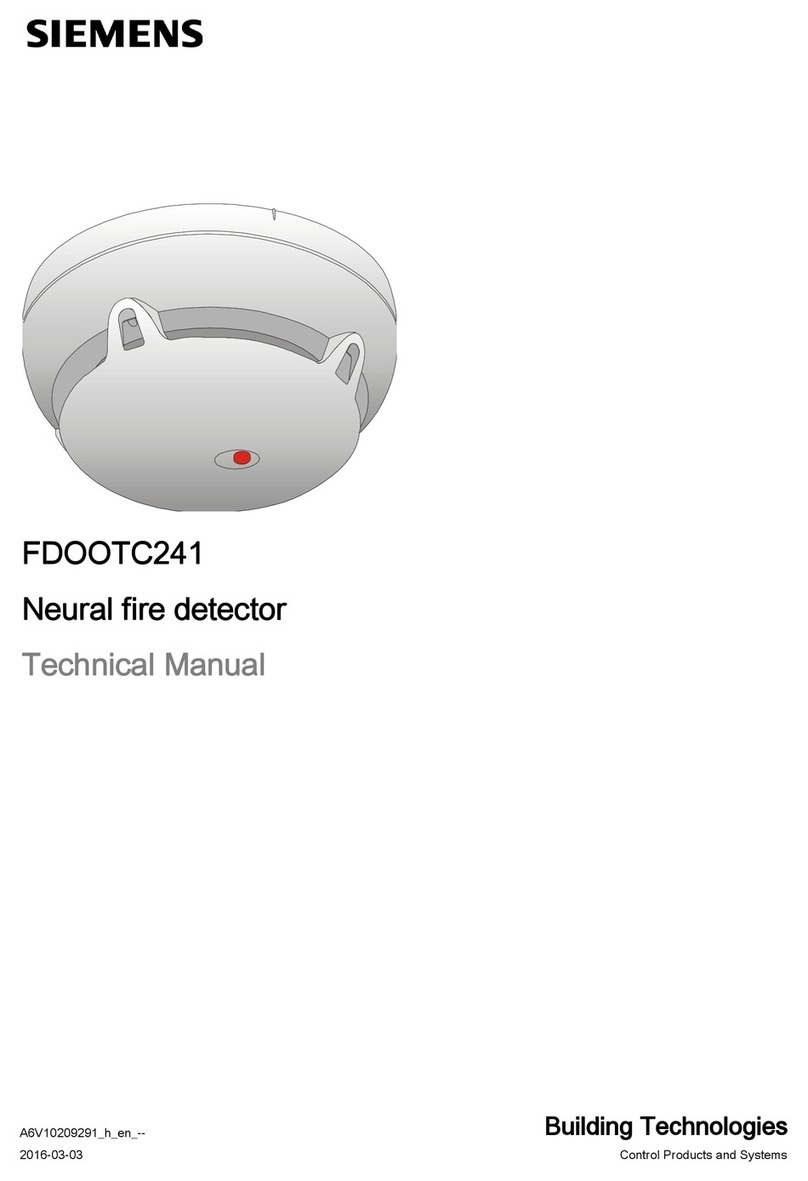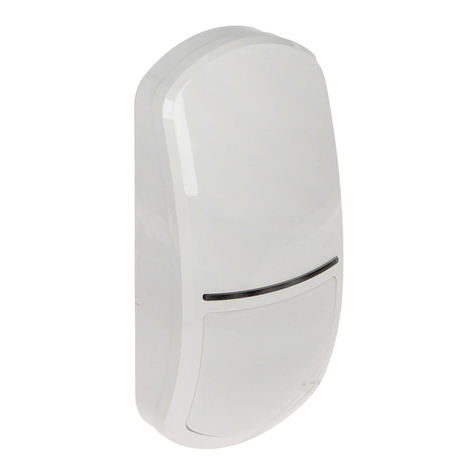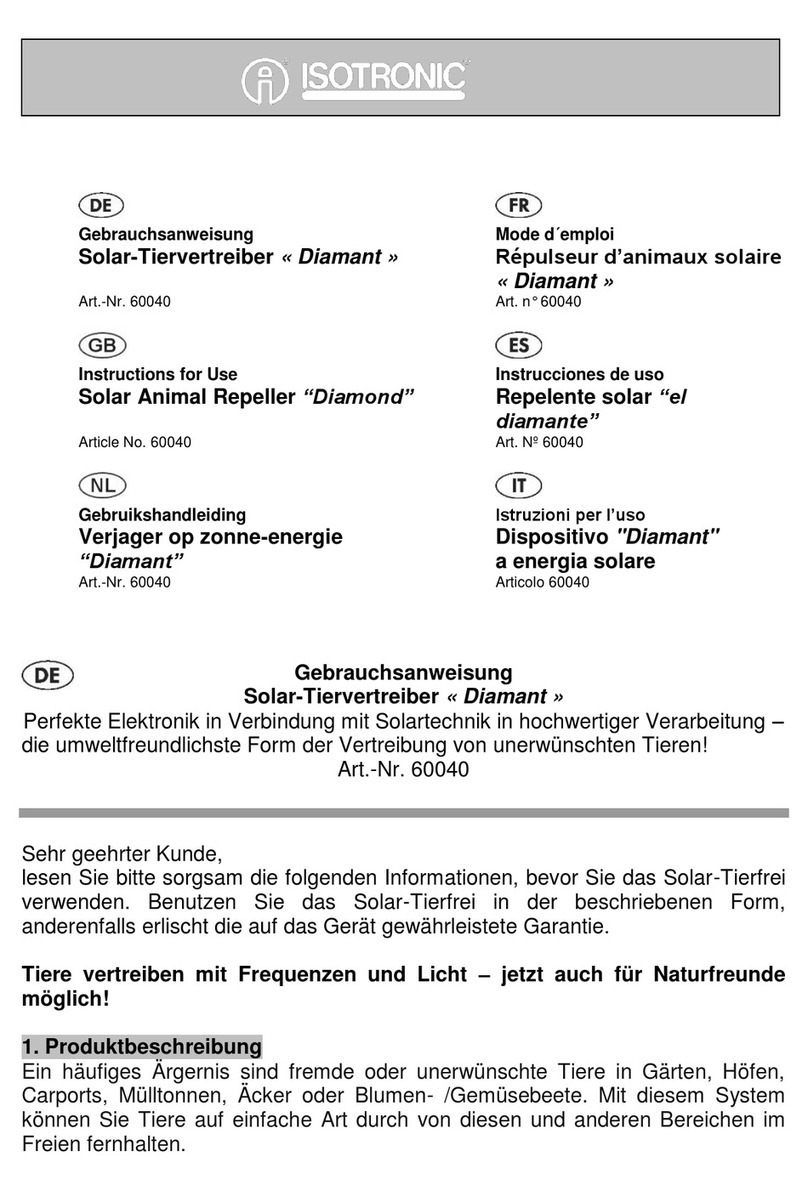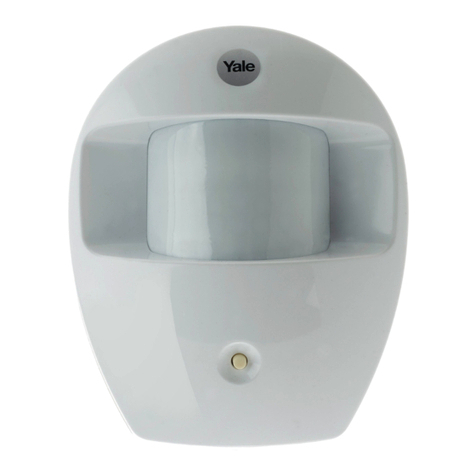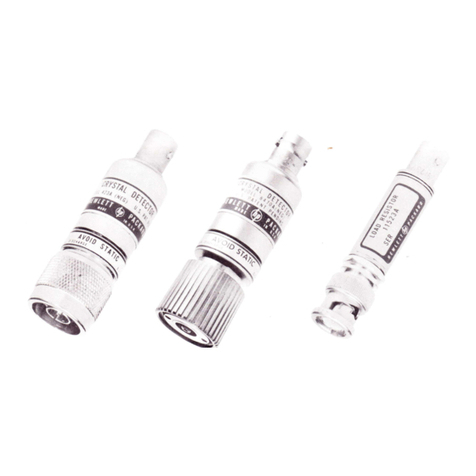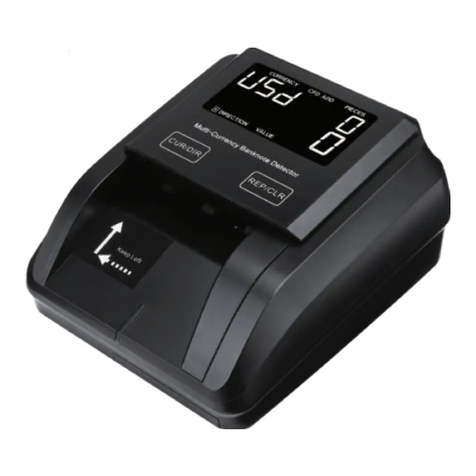Bascom_turner GAS-EXPLORER II EGI-201 User manual

BASCOM-TURNER
INSTRUMENTS
GAS-EXPLORER IIDETECTORS
OPERATION MANUAL
NATURAL GAS, CARBON MONOXIDE, OXYGEN,
HYDROGEN SULFIDE
Part Number OM-0220

LIMITED WARRANTY
Bascom-Turner Instruments warrants Gas-Explorer Detectors to be free from
defects in materials and workmanship for one year following the date of shipment.
This limited warranty applies to the original purchaser of the Detector and is not
transferable except by Bascom-Turner's authorized Distributors.
The instruments described in this manual are produced with standard commercial
parts, any of which may fail under some circumstances. Although the probabilityof
such failure is low, it is not zero. Accordingly, all personnel using such instruments
must be trained to recognize instrument malfunctions and to have such instruments
repaired promptly. Bascom-Turner offers no warranty that failures will not occur –
only that when theyoccur, theywill bepromptly cured with thefollowing procedure:
During the limited warranty period, we will repair or replace, at our option, any
defective products or parts at no additional charge. A return merchandise
authorization (RMA) number must be obtained prior to returning a detector to
Bascom-Turner. A detector returned to Bascom-Turner with probe and water-
block filter, shipping prepaid, will be repaired, calibrated and returned second day
air. Warranty repairs do not include pump cleaning, filter replacement and
calibration. All replaced parts and products become the property of Bascom-Turner
Instruments.
This limited warranty does NOT extend to any Detectors which have been damaged
as a result of accident, abuse, modification, misuse such as failure to follow the
operating instructions provided by Bascom-Turner Instruments, or other
contingencies beyond our control. No other warranty is expressed or implied.
Bascom-Turner is not liable for consequential damages.
CAUTION
Personnel who operate, calibrate, or repair this instrument must first read and fully
understand this manual in its entirety.
For use in Class I, Division 1, Group D atmospheres (Propane and Methane).
These products have not been tested for intrinsic safety in oxygen enriched
atmospheres.
Change batteries, service, and use the USB interface only in areas known to have
non-hazardous atmospheres.

TABLE OF CONTENTS
FEATURES
SPECIFICATIONS
PART 1. OPERATION
1. The Gas-Explorer Detectors...................................................................................
1
2. Essential Operating Practice ..................................................................................
2
3. Operational Description.........................................................................................
4
4. Instrument Checks..................................................................................................
8
5. Interference from Other Gases, Liquids, or RFI....................................................
9
6. Change of Batteries................................................................................................
10
7. Probes.....................................................................................................................
11
8. Routine Maintenance .............................................................................................
12
Appendix 1: Main Sequences for Operation Modes...........................................
14
PART 2. SETUP AND CALIBRATION
1. Setup.......................................................................................................................
15
2. Further Setup Parameters.......................................................................................
16
3. Calibration..............................................................................................................
17
PART 3. THE USB INTERFACE
1. Downloads .............................................................................................................
18
2. Reports...................................................................................................................
20
3. Maintenance...........................................................................................................
23
PART 4. MAINTENANCE
1. Sensor and Pump Installation.................................................................................
24
ACCESSORIES AND SPARE PARTS ......................................................................
26
i

ii
FEATURES
The Gas-Explorer IIportable methane, and combined methane, carbon monoxide and
oxygen detectors are intrinsically safe, microprocessor based instruments designed to test ambient
airand flue gas over a wide temperature range.
These detectors have many features for easy and reliable operation:
•Absolute Compliance (Optional)
The instrument automatically calls for and requires calibration at the end of a pre-
determined interval.
•Automatic Data Storage and Reports
Automatic storage of time and mode-stamped readings. Automatic storage of the last
24 calibrations. Automatic generation of reports.
•Automatic Calibration
Calibration is performed automatically using Bascom-Turner's calibration gas.
•One-Gas Calibration (Optional)
Calibration of the thermal conductivity sensor (vs methane) is automatically carried
out with the One-Gas routine. Alternatively, the sensor can be calibrated with System
Gas.
•Measurements Over the Full Range of Gas
The instruments detect methane over the full range of methane concentrations up to
100% GAS. Peak and current readings are displayed simultaneously.
•Track Gas
A sensitive, calibrated scale with 20ppm resolution and quick response makes it easy
to find gas leaks.
•Bar Holing
Peak and sustained bar-hole readings are automatically displayed after gas is pumped
for a precise, fixed time.
•Purge
Measures the concentration of natural gas with resolution of 0.1% by volume as sensed
by the thermal conductivity sensor.
•Automatic Sampling
An intrinsically safe pump automatically samples ambient air, flue gas, or bar hole gas.
•Automatic Self-Tests
Automatic checks of battery, sensors, and pump. Tests for blockage and for tight
connection of probe to instrument.
•Audible and Visual Alarms
Audible and visual alarms individually set. Continuous monitoring of natural gas, and
(optionally) CO and O2.
•Easy-to-Use
Simple operation without complicated or confusing displays. A short “help” manual
is stored onboard.

SPECIFICATIONS
Gases Detected Natural Gas (Methane)
Carbon Monoxide (CO) [Optional]
Oxygen (O2) [Optional]
Hydrogen Sulfide (H2S) [Optional]
Sensors Dual Catalytic Combustion (CH4)
Thermal Conductivity (CH4)
Electrochemical (CO, H2S, O2)
Ranges
GAS 0 to 10,000 ppm CH4 by volume
0 to 100% CH4 byvolume
PPM CO 0 to 2000 ppm carbon monoxide
% O2 0 to 40% by volume
PPM H2S 0 to 100 ppm by volume
Resolution
GAS 20 ppm from 0 to 10,000 ppm
0.05 vol % from 0 to 5 vol %
1.0 vol % from 5 to 100 vol %
CO 1 ppm
O2 0.1 vol %
H2S 1 ppm
Warm-Up Time 60 seconds
Response Time: CH4: 0.6 seconds (Track Gas)
2.0 seconds (Monitor)
H2S/CO: 45 seconds
O2: 60 seconds
Operating Temp. -20oC to 40oC (0oF to 105oF)
Storage Temperature -40oC to 60oC (-40oF to 140oF)
Data Storage
And
Reports
24 Calibrations
2 to 3 months readings (typical)
Exposure and Bar-Hole Measurements,
Calibration History, Sensor Sensitivity,
Operational Periods by User and Unit ID,
Humidity 0 to 95% RH (non-condensing)
Power Supply Two C-size Alkaline or
Two C-size Rechargeable NiMH
Office Reports Continuous Operating
Time per Battery Set 10 hours typical (25oC)
Accuracy CH4:
(0º to 35ºC) 2% of reading 20 ppm
0.1% to 5%;
2.0% from 5% to 100 vol %
Weight 24 oz. (680 g)
CO: 5% of reading 10 ppm
O2: 0.2% vol %
H2S: 5% of reading 1 ppm
iii

1
PART I. OPERATION
1.
THE GAS-EXPLORER DETECTORS
This manual describes the operation of the family of Gas-Explorer detectors for natural gas, carbon
monoxide and oxygen:
Detects natural gas and displays it as PPM, % LEL or % GAS
Detects natural gas and displays it as PPM and % GAS
Detects natural gas and carbon monoxide and displays it as PPM,
% LEL(301) or % GAS(311), and PPM CO (parts per million of CO)
Detects natural gas and oxygen and displays PPM, % LEL or % GAS, and
% Oxygen
Detects natural gas and oxygen and displays PPM or % GAS and
% Oxygen
Detects natural gas, CO, and oxygen and displays PPM, or % LEL(411) or
% GAS(412), PPM CO and % Oxygen
Detects natural gas, CO, and oxygen and displays PPM or % LEL(611) or
% GAS(612), PPM CO, PPM H2S and % Oxygen
All models display gas in ppm in the Track Gasmode.
All models may be used to test ambient air and bar hole to locate natural gas leaking from
pipes and other conduits. All models which detect carbon monoxide (CO) may be used to test for
CO in ambient air, flue gas, and gases given off by appliances.
A detector alerts the user acoustically and visually, by “flashing”the symbol(s), for
detected gas(es), whose concentration exceeds preset limits. Visual alarms are displayed in-
between readings. For example, the display will flash “CO”, approximately every two seconds,
in-between normal Monitor mode displays. If the concentration of natural gas also rises aboveits
alarm limit, the display will flash “GAS”, then a normal Monitor mode display, then “CO”, and so
on. Simultaneously, the sound alarm will be on.
Visual alarm symbols are “GAS” for natural gas, “CO” for carbon monoxide, “HS” for
H2S, “Low Oxygen” for low oxygen, and “High Oxygen”for high oxygen.
Factory set alarm limits are 1.0% methane, 35 ppm CO, 9ppm H2S and 19.5% for
low and 23.0% for high oxygen.
No alarms are given in the Bar Hole mode. The low battery warning is given in all modes.
OPTIONS
All units may have (optionally) Blue Tooth (Option BT) and/or GPS (Option GPS). The former
may be used for transmitting stored calibrations, while the latter assigns coordinates to all
measurements (gas readings) obtained by an instrument. GPS coordinates are automatically stored
together with corresponding readings of all sensors on-board.
Model
EGI -201
-
Model
EGI -211
-
Model
EGC-301
and -311
-
Model
EGO-321
-
Model
EGO-322
-
Model
EGA-411
and -412
-
Model
EGA-611
and -612
-
-
WARNING: Each detector responds to the gases for which it was designed. Other toxic
or dangerous gases may not be detected.

2

3
2.
ESSENTIAL OPERATING PRACTICE
Gas-Explorer detectors are easy to use. A detector is turned on by pressing the left button;
its operationiscontrolledbythree“Soft” buttonswhosefunctionisshownonthedisplay. Themiddle
button generally toggles “Mute” on and off in Track Gas mode (see later). Double-clicking the
middle button turns the backlight continuously ON or OFF depending on its previous state. Once
the appropriate display is selected, operation is automatic. However, a few general rules must be
followed to insure reliability.
Pump. Gas-Explorer detectors have a built-in pump and depend on this pump for their
operation. If the pump is not functioning normally, the instrument will not function properly. It is
therefore essential to check the pump each time the instrument is turned on.
Pump Test: Connect the probe you plan to use and turn the instrument on. After the display
shows “Block Intake”, block the probe at its intake to show “Pump OK”.
If “Pump OK”does not appear, tighten all connections and repeat the test. If a block
condition is still not observed, remove the probe and block directly the inlet. If “Pump OK”still
does not appear, return the instrument for repair.
A pump test can be carried out as above at any time during normal operation of the
instrument. If there is any indication that the pump is not operating normally, the instrument
should not be used until repaired.
Filters. Dust and water-block filters protect the sensors and the pump from dust and
accidental intake of liquid water. Just as a car would not be operated without air and fuel filters,
do not operate a detector without a filter on the probe. Operation without this filter will
eventually degrade the sensors and the pump. It also voids the limited warranty.
It is essential that the filter be replaced monthly or sooner if it turns brown. Operation
without a filter will degrade the natural gas sensor and will void the warranty. Filters are available
from Bascom-Turner in packages of five, Part No. WF-505.
Models VGA-611 and VGA-612 require special filters available from Bascom-Turner in
packages of five, Part No. WF-705.
Zero Check. All sensors drift to some extent over time. Sensor drift is corrected by zeroing
if the drift is within 0.1% vol. GAS (and 10ppm CO if the unit is equipped with a CO sensor). If
the drift is outside these limits, “NO GO”is displayed and the user is asked to autozero the unit in
“clean” outdoor air. The user can override this limit and re-zero the instrument unless the zero has
drifted over 1.0% vol.GAS (or 20ppm CO if the unit is equipped with a CO sensor), in which case
the instrument must be checked by a trained professional (the sensor may need replacement). It is
important that the zero adjustment be done in clean air, for example, outdoors. If the sampled gas
is not clean, a systematic error may be introduced in subsequent measurements.
Test and Calibration. Gas-Explorer detectors must be checked and calibrated periodically
with gas of known composition. The catalytic combustion, carbon monoxide, and hydrogen sulfide
sensors depend on catalysts which may lose activity or get poisoned during use. When this
happens, there will be diminished response.
The necessary frequency of calibration depends on actual use and on the concentration of
catalyst poisons in the sampled gas. This concentration is, of course, not generally known.
WARNING: On a call, turn the instrument on outdoors, not indoors.

4
A detector can be tested with methane bump gas. Such tests merely verify that the gas
sensor(s) are in operating condition. To verify and adjust, if necessary, their sensitivity they must
be calibrated.
A detector can be automatically calibrated in approximately one minute using Bascom-
Turner's calibration gas (2.5% CH4 and 100 ppm CO in air). Given the ease and speed of automatic
calibration, it pays to calibrate as frequently as possible, and certainly, no less than monthly.
Accuracy. A properly operating and calibrated detector will respond with the specified
accuracy. If combustible gases other than the gas used for calibration are likely or suspected, the
instrument cannot be relied upon to give a proper indication of their concentration and hence of
how close to their combustible limits they may be. For example, the detector responds quite
differently to gasoline, to methane, and to propane. Accordingly, readings of % LEL (or its
equivalent in percent gas) refer only to the calibration gas and can be relied upon only in this
respect in assessing an atmosphere sampled by the detector. Furthermore, concentrations displayed
by the detector refer to a local sample at the tip of the instrument probe. Low gas concentrations
at one spot do not necessarily mean that the gas concentration is low throughout a wider area.
Safety. These instruments measure the concentration of natural gas in air and give, more
generally, an indication of the presence of other combustible gases. When used by trained
personnel, they constitute one element for assessing the safety, or lack thereof, of a particular
atmosphere. However, they must not be relied upon by themselves for judging safety; all
other significant factors must be taken into account. The measured concentration refers only to
the immediate vicinity of the probe –concentrations in a wider area may be significantly different.
A trained technician should consider possible interferences, physical or chemical, and be aware
that calibrated values are only valid in air. If other gases, including inert gases such as carbon
dioxide are present, the measurements may not be reliable. Finally, although there are built-in
safeguards, a specific instrument may malfunction. It is therefore imperative that other indicators,
including, for example, odorant levels, must be taken into account.
WARNING: Each detector responds to the gases for which it was designed. Other toxic
or dangerous gases may not be detected.
WARNING: Catalytic combustion sensors do not respond in inert or reducing
atmospheres. They should not be used for detecting combustible dusts or
mists.

5
3.
OPERATIONAL DESCRIPTION
To conserve the batteries, turn the instrument OFF when not in use.
The instrument is controlled by three push button switches whose function changes with
each particular display (see Appendix 1). The function of each push button is shown on the display
in each case. In Track Gas mode, the middle button silences the beeper (“mutes” the instrument).
Startup Sequence. To turn the instrument on, press the left switch. A series of screens is
automatically displayed preparatory to entering the first operational mode, viz. “Monitor”. Along
the way, a number of specialized screens can be used to access specialized functions.
The first screen shows the Model Number and the second displays gases detected by the
instrument and provides access to the USB interface (see Part 3) or to a display of the serial
number. The next screen shows the date and time. To edit the date or time, press the right “Edit”
button. The first digit of the hour will begin flashing and can be changed from 0 to 1 or 1 to 0 by
pressing the right “Update” button. Pressing the “Next” button advances the flashing digit which
can then be edited (or not) by pressing the right (or left) button, and so on. The same screen
provides access to a short manual by pressing the left “Help” button.
Following the Edit/Help screen, the pump is tested (“Block Pump” screen). If no block is
detected in 40 seconds, “Check Probe” is displayed, followed by “Remove Probe and Block
Intake” and finally “Repair Pump” followed by an automatic turning off of power.
The next display suggests a “Calibrate by [a date thirty days from the date of the last
calibration]” and an opportunity to calibrate (see Part 2, Calibration). If calibration is not chosen,
the instrument proceeds to enter the operational mode of “Monitor” (see below).
The period of thirty days between calibrations is only a default value. The instrument
should be calibrated as often as possible, ideally every day. In any case, if poisoning of the natural
gas sensor or some other problem is suspected, the instrument should be promptly checked by
calibration with CAL Gas (see Part 2, Calibration).
Backlight. Pressing any button backlights the display for 20 seconds. To backlight any
display, press the middle button twice (if in Track Gas mode, this sequence leaves the instrument
in its original state –mute or not mute). The backlight remains on until a new display is entered or
the middle button is double-clicked again. An exception to this procedure is during bar holing
(middle button initiates sampling). Pressing the middle “Go” button automatically backlights the
display long enough (60 seconds) to read the results.
Turning the Instrument Off. The instrument can be turned off from most displays. Such
places are obvious when a particular button is marked “Off.”
When a direct “Off” button is not available, you may follow the procedures suggested below:
1.
At the USB access display, press the left “USB” button and then after the new
screen, the right “Off” button.

6
Operational Modes. The instrument operates in four distinct modes: “Monitor”, “Track
Gas”, “Bar Hole” and “Purge”. A mode may be entered from the Mode Menu screen which can
be accessed by pressing the “Mode” button from most screens. In the Mode Menu, pressing the
“Yes” button will enter the mode pointed to by the arrow. Pressing the “No” button will move the
arrow down the list to the next mode. The instrument enters Monitor mode at startup by default.
Monitor: The detector shows the concentration of natural gas (methane) in air in steps of
0.05% GAS (1% LEL) up to 5% GAS (100% LEL) and then in steps of 1% GAS up to 100% GAS.
The concentrations of CO, H2S (HS), and O2 are also shown if the unit is equipped with the
corresponding sensors (see below).
The peak reading for GAS is retained and displayed along with the current readings until
another mode of operation (Track Gas or Bar Hole) is chosen, or a new zero is obtained, or the unit
is turned off.
Models EGI-201, EGC-301, EGO-321, EGA-411, and EGA-611 display concentrations in
increments of 1% LEL up to 100% LEL and then in increments of 1% vol. from 5% to 100% GAS.
All other models display % vol. gas in increments of 0.05% up to 5% and then in increments of
1% to 100% GAS.
Track Gas: Connect an appropriate probe (see Section 7) and select “TRACK”. The
display shows “Track Gas” for a few seconds. After warm-up, the display shows the concentration
of gas in air in parts per million by volume (ppm). Advance a probe along the pipe or other conduit
suspected of having a gas leak. The beeper will sound if the ambient concentration of gas rises
above 20ppm. The number of beeps will increase as the concentration of gas increases according
to the chart below.
2 Beeps: 20 ppm –100 ppm
3 Beeps: 100 ppm –250 ppm
4 Beeps: 250 ppm –500 ppm
5 Beeps: 500 ppm –1,000 ppm
6 Beeps: 1,000 ppm –5,000 ppm
Since methane is lighter than air, track a conduit from above whenever possible.
Sometimes it is desirable to silence the beeper during a leak survey. To silence the beeper, press
the middle switch. “Mute” will appear on the display and the beeper will be silent. If the gas
concentration goes over 10,000 ppm, (1% Gas) the unit automatically enters the Monitor Mode.
As in the Monitor Mode, the peak reading for Gas is retained and displayed until another
mode of operation is chosen, or a new zero is obtained, or the unit is turned off.
Bar Holing: The detector may be used to measure gas levels in sampling holes used for
locating underground natural gas resulting from seepage or leaks in a conduit. Gas concentrations
in a bar hole near a significant leak will exceed several percent. Therefore an alarm for gas is
likely, but since it is not relevant to the ambient atmosphere above ground, it is automatically
suppressed. During bar-holing, the alarms for all gases are automatically turned OFF.
To bar hole, select an appropriate probe (see Part 1, Section 7) and set the front panel to
Bar Hole (BH). The instrument automatically clears any residual gas and checks for clean air. The
pump is then turned off and the instrument is ready for bar holing. After inserting the probe into
the bar hole, press the “Go” button (the middle switch). The pump is turned on and the instrument
samples gas for a fixed time (factory set time is 15 seconds). Readings during sampling are shown
on the display. At the end of the fixed time for sampling, the instrument turns off the pump, and
displays the peak and sustained readings. Both values are in % GAS.

7
If in the course of bar holing, water is encountered, press the left “Stop” button to stop the
pump. Use of a water-stopper (see Figure 2 in Section 8) will prevent water from entering the
instrument.
Purge: The purge mode measures the concentration of natural gas in nitrogen with a
resolution of 0.1% by volume from 0.0% to 100.0% as sensed by the thermal conductivity sensor.
Purging air-filled lines into service requires lowering the oxygen content to less than 9.7% (or
natural gas concentration over 70%).
WARNING: If a check is to be made for trace amounts of gas, for example around the
foundation of a structure, the Monitor or the Track Gas –not the Bar Hole
- mode should be selected.

8
To Detect Carbon Monoxide
Carbon Monoxide in Ambient Air
Connect an appropriate probe with a water-block filter and select the Monitormode. After
warm-up, the display shows the concentration of CO in parts per million (ppm). If the air is clean
(contains no carbon monoxide), the display should read zero. If it does not, use the right “Zero/Off”
button to obtain a new zero in clean air.
Carbon Monoxide in Flue Gas
Connect the flue gas probe, with an attached flue gas filter, to the water-block filter on the
hose and select the Monitor mode. After warm-up, insert the probe into the flue and read the
concentration of CO in parts per million. A flue gas check of CO should take one minute or less.
For every minute of flue gas sampling allow the detector a minute of room air sampling to dry the
filters.
Note: The standard flue gas probe and filter are suitable for spot checks lasting a
minute or two. For measurements of CO in flue gas over longer periods use an
Extended Duty Flue Gas Probe and Filter (Part No. FP-012).
“Air-Free” CO Flue Measurements.
The EGA-411/412 and 611/612 detectors can display measurements of CO on an “air-free”
basis if this feature is selected (see Part 2). When this selection is made, the measured CO
concentration is referred to air-free flue gas according to:
"Air
−
Free"PPM CO
=
20.9
(20.9
−
measured
% 0
2
)
(
measured ppmCO
)
The instrument displays CO concentrations on an air free basis using the above relation.
The CO reading on the display is label by ppm AFCO, i.e. air-free CO. This calculation is used
up to 16% Oxygen. Beyond this, CO concentrations are displayed without conversion, i.e. the
“air-free” formula is not used.
WARNING: Do not touch the flue probe immediately after a measurement. Wait until
it cools. Running the instrument in air helps cool the probe.
The filter provided with the flue probe must be used to avoid interference by
nitrogen oxides in combusted gas. A filter is good for about three months of
ordinary use. It should be replaced or refilled when about 90% of its purple
material has changed color to brown, or when it gets clogged or flooded (see
"Accessories and Spare Parts", Flue Gas Filter, Part No. FF-005 and Purple
Beads and Spare Retaining Disks, Part No. PR-050).
CAUTION:

9
4.
INSTRUMENT CHECKS
Automatic Sensor Check
If a gas sensor fails (opens up), the display shows “Replace Methane Sensor”.
Automatic Pump Check
If the intake is blocked, the display shows “Flow Blocked”and the detector beeps untilthe
problem is cleared. This check is carried out whether or not a probe is being used. During the
power on sequence, if a blocked flow is not detected within 40 seconds (from manually blocking
the intake to the pump), the detector displays “No Block Check Probe” then “Remove Probe and
Block Intake”, and finally “Repair Pump”.
Check for Tight Connections
To check for tight connections, block the probe inlet to observe “Flow Blocked”on the
display. If “Flow Blocked”fails to appear, there may be a leak.
Automatic Zero
The zero is adjusted automatically when “Zero”is chosen from an appropriate display.
WARNING: The instrument will not operate when first turned on if it fails to block when the air
intake is blocked. Subsequently, however, connections can only be checked by
blocking the probe inlet and observing “Flow Blocked” on the display. If “Flow
Blocked” fails to appear, the probe and/or inlet must be checked for leaks.
CAUTION: Zero adjustment must be carried out in clean air; otherwise, a systematic error will be
introduced in subsequent measurements. The instrument will auto zero in concentrations
of methane below 0.10% GAS and concentrations of CO below10 ppm.

10
5.
INTERFERENCE FROM OTHER GASES, LIQUIDS, OR RFI
The methane detectors use two sensors:
i)
A catalytic combustion filament calibrated with methane. It is used up to aboutthe
lower flammable limit (5.0% by volume) of methane.
ii)
A thermal conductivity sensor calibrated with methane. It is used from the lower
flammable limit (5.0 vol %) to 100 vol % of methane.
Models EGC-301 and EGC-311 (methane and carbon monoxide detectors) use the sensors
listed above and:
iii)
A three-electrode, electrochemical cell for carbon monoxide.
Models EGO-321 and EGO-322 (methane and oxygen detectors) use the methane sensors
listed above and:
iv)
A two-electrode, electrochemical cell for oxygen.
Models EGA-411/412 use all four sensors.
Models EGA-611/612 use the four sensors listed above and an electrochemical H2S sensor.
Gases, or liquids with appreciable vapor pressure, which may interfere with the detection
of methane include substances which can be combusted on the catalytic combustion filament
(examples are ethane, propane, ethylene, propylene, octane, and the like) and substances which
differ in thermal conductivity from air (examples are hydrogen, helium, carbon dioxide, other
hydrocarbons).
Gases or vapors which may interfere with carbon monoxide detection include substances
which can be electrochemically oxidized or reduced on the working electrode of the
electrochemical sensor. Examples are hydrogen, hydrogen sulfide, oxides of nitrogen, alcohols,
and unsaturated hydrocarbons.
Many of the substances that interfere with CO are removed by the flue gas filter (Part No.
FF-005). This filter can be used for both flue gas measurements and for ambient air measurements
of CO whenever the ambient concentration of other oxidizable substances issignificant. This filter
should not be used in ambient air with EGA-611/612.
Radio Frequency Interference
The Gas-Explorer detectors have an interior coating on their cases to suppress radio
frequency interference (RFI).
WARNING: The methane and CO sensors use catalytically active surfaces which may be
poisoned by air contaminants. These sensors should not be exposed to atmospheres
that contain silicones, halogens and halides, such as chlorides, and volatile
compounds containing lead or antimony. If exposure toatmospheres that adversely
affect the sensors is suspected, the detector should be recalibratedpromptly.

11
6.
CHANGE OF BATTERIES
Gas-Explorer detectors may be powered by two (2) alkaline (non-rechargeable) C-size
batteries (1.5V, Type AM-3) or by two rechargeable nickel metal hydride (NiMH) batteries sold
by Bascom-Turner. The batteries are good for at least eight, and typically ten, hours of continuous
operation. When the batteries are drained to about one hour of remaining continuous use, the unit
alarms and the display flashes “Low Batteries”between readings. If battery life is over, the unit
displays “Low Batteries”and powers down. The batteries must be changed to make theinstrument
operational again.
To change batteries:
1.
Turn instrument OFF.
2.
Remove spent batteries.
a)
Unscrew the battery cap and slide out two C-cells.
b)
Discard two alkaline C-cells or recharge the NiMH cells.
3.
Insert two, fresh C-size alkaline batteries or two charged NiMH C-sized cells.
4.
Replace the battery cap and give it one quarter turn (battery cap bar vertical).
Note that the batteries are inserted with the positive terminal first.
If the instrument does not operate after battery replacement, there is a high probability that
a battery has been inserted with the wrong polarity. Re-insert the batteries taking extra care to
insert each battery correctly.
Note: Always replace a set of batteries with a new set. When operating in cold weather (below
-10oC) use a fresh set of batteries, if possible. Alkaline batteries have shortened life in cold
weather; NiMH batteries are recommended.
WARNING: The batteries must be changed in an atmosphere known to be non-
hazardous.
WARNING: Do not attempt to charge the alkaline (non-rechargeable) batteries because
they may leak or vent.
WARNING: Use only alkaline batteries or rechargeable batteries sold by Bascom-
Turner in a Gas-Explorer.
WARNING: To reduce the risk of a battery venting, do not mix old batteries with new
batteries, or mix batteries from different manufacturers.
WARNING: Do not attempt to service the instrument in a hazardous atmosphere.

12
7.
PROBES
Metal Gooseneck Probe
The metal gooseneck probe (Part No. GP-514) is a 14 inch long flexible probe which
connects to the dust and water-block filter and has a quick connect fitting.
Standard Probe
The standard probe (Part No. SP-306), a rigid tube, connects to the dust and water-block
filter. If extra length is desired, an extension (7”, SP-308) is screwed finger-tight onto the end of
the probe. A rubber gas collector (Part No. RT-107) is useful for finding leaks under windy
conditions.
Flue Gas Probe
The flue gas probe (Part No. FP-110) is a telescoping metal probe screwed finger-tight into
the flue gas filter. The other end of the filter attaches to the dust and water-block filter. This probe,
together with its filter, may also be used for CO measurements in ambient air.
Bar Hole Probes
There are five optional probes suitable for bar holing:
Bar Hole/Ceiling Probe (Part No. BP-034) 34" long, clear, one hole at end.
Bar Hole Probe (Part No. BP-134) 34" long, clear, side holes.
Bar Hole Probe (Part No. BP-136) 36” long, fiberglass, one hole at end.
Bar Hole Probe (Part No. BP-236) 36" long, fiberglass, side holes
Bar Hole Probe (Part No. BP-536) 36" long, steel, side holes.
The bar hole/ceiling probe has a single inlet on the end and comes with a rubber gas
collector (Part No. RT-030) useful for finding leaks in overhead pipes. The stainless steel probe
has an electrically insulated handle. Bar hole probes are designed to be attached to the water block
filter on the hose. A convenient way to release water from a bar hole probe is with a water-stopper
(Part No. WS-001) described in Section 8.
CAUTION: Never attach the flue gas filter cartridge directly to the sample hose - always use
a dust and water-block filter.
WARNING: Hold the probe without touching metal while it is in the flue and immediately
afterwards. Running the instrument in air after a measurement will help
cool the probe quickly and dry the filters.
WARNING: Hold the steel bar hole probe only by the insulated handle to avoid
electrical shock from buried power lines.
CAUTION: Do not use this probe for flue gas measurements. The plastic probe may become
soft, deform or decompose.

13
8.
ROUTINE MAINTENANCE
Dust and Water-block Filter
A filter, housed in a knurled nut, removes particles of dust and dirt and blocks water. Do
not insert objects into the water block filter as they may puncture the filter. The filter needs to be
replaced monthly or sooner if it turns brown. Replacement dust and water-block filters are
available as Part No. WF-505 (package of 5 filters). Models EGA-611/612 use WF-705 filters
only.
Figure 1. WF-505.
Inlet Dust Filter (IF-705)
Removal of the intake connector (used to attach the sampling system of choice) of the
detector exposes a metal filter pressfit onto the intake. These filters are not a substitute for dust
and water-block filters as they will not block water or remove very fine dust and dirt. If this filter
gets blocked, it may be cleaned with compressed air or replaced.
Water-stopper (WS-001)
The water-stopper (Figure 2) provides a quick way to continue
bar holing if water is encountered in a bar-hole. The water-stopper is
inserted between the dust and water-block filter and the bar hole probe.
A float inside the water-stopper is connected to a plunger which blocks
flow whenever the float is lifted by water. Water is released and the
plunger returned to its normal position by depressing a release push-
button.
Figure 2. Water-stopper
CAUTION: Do not use a Gas-Explorer without a three-way or dust and water-block filter.
Do not use a three-way or dust and water-block filter with a puncture.

14
Dust-Stopper (DS-001)
The dust-stopper is a filter with a large surface area on which dust can collect without
slowing the sampling rate of the Gas-Explorer. The filter element is easily cleaned or replaced by
removing the threaded cap and either blowing off the filter element or pulling it off and replacing.
Replacement dust filter cartridges are available as Part No. DF-105. The dust-stopper should be
used between the dust and water-block filter and the probe or water-stopper.
Flue Gas Filter
This filter is screwed, finger-tight, between the telescoping metal probe and the dust and
water-block filter. It must be used for CO measurements in flue gas and may also be used for CO
measurements in ambient air. The beads in the filter cartridge should be replaced when about 90%
of the material has changed color from purple to brown or when it becomes blocked by soot or
water. Filter beads for refilling approximately 50 cartridges are available as Part No. PR-050.
Replacement flue gas filters are available as Part No. FF-005 (package of 5 filters).
To refill the filter cartridge, remove the threaded top and pour out the spent filtermaterial.
Retrieve the plastic retainer disk from the spent filter material. Fill the cartridge with fresh filter
material to bottom of threads and place the plastic retainer disk flat on top of the filter material.
Screw in top until finger tight and check seal by carrying out a block test with the detector.
Heavy Hydrocarbon Filter
A heavy hydrocarbon filter, filled with activated carbon, can be used with the standard
probe or the bar hole probe on a one-time-only basis. Activated carbon adsorbs gasoline and other
heavy hydrocarbons (for example, propane or butane) which interfere with methane detection. In
order to keep the filter material from adsorbing hydrocarbons prior to use, the filter is fitted with
plastic end caps which must be removed just before use. The filter should be either discarded after
use or refilled with activated carbon and recapped with the plastic end caps. This filter is designed
to be screwed finger-tight between the probe and the dust and water-block filter. Activated carbon
for refilling approximately 50 cartridges is available as Part No. HR-050. The refill procedure is
the same as described for the flue gas filter. Heavy hydrocarbon filters are available as Part No.
HF-005 (package of 5 filters).
The heavyhydrocarbon filter can also remove some alcohols and unsaturated hydrocarbons
which can interfere with CO readings. The filter should be discarded or refilled after each use.
Do not remove or puncture the white filter in the bottom of the filter cartridge.
If this filter becomes damaged, discard the filter cartridge.
CAUTION:

15
APPENDIX 1
MAIN SEQUENCES FOR OPERATION MODES
Off
Yes
Monitor
Track
Barhole
Purge
No
Zero|Off
Mode
Monitor
CO
O2
Zero|Off
Mode
Track
PPM
peak
Off
Mode
Bar Hole
BH/Go
Off
Mode
Purge
%Gas
CO
O2
Zero|Off
Mode
Monitor
%LEL/%Gas
peak
This manual suits for next models
9
Table of contents
Popular Security Sensor manuals by other brands
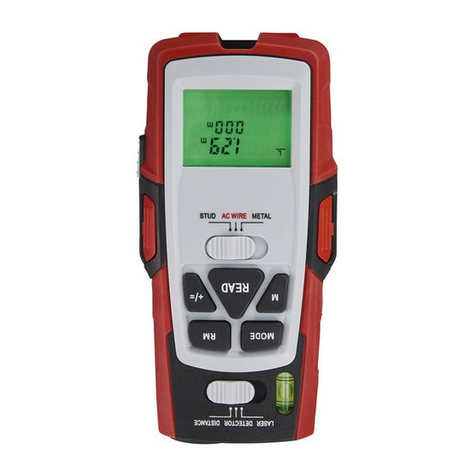
Powerfix Profi
Powerfix Profi PMDL 5 B1 operating instructions
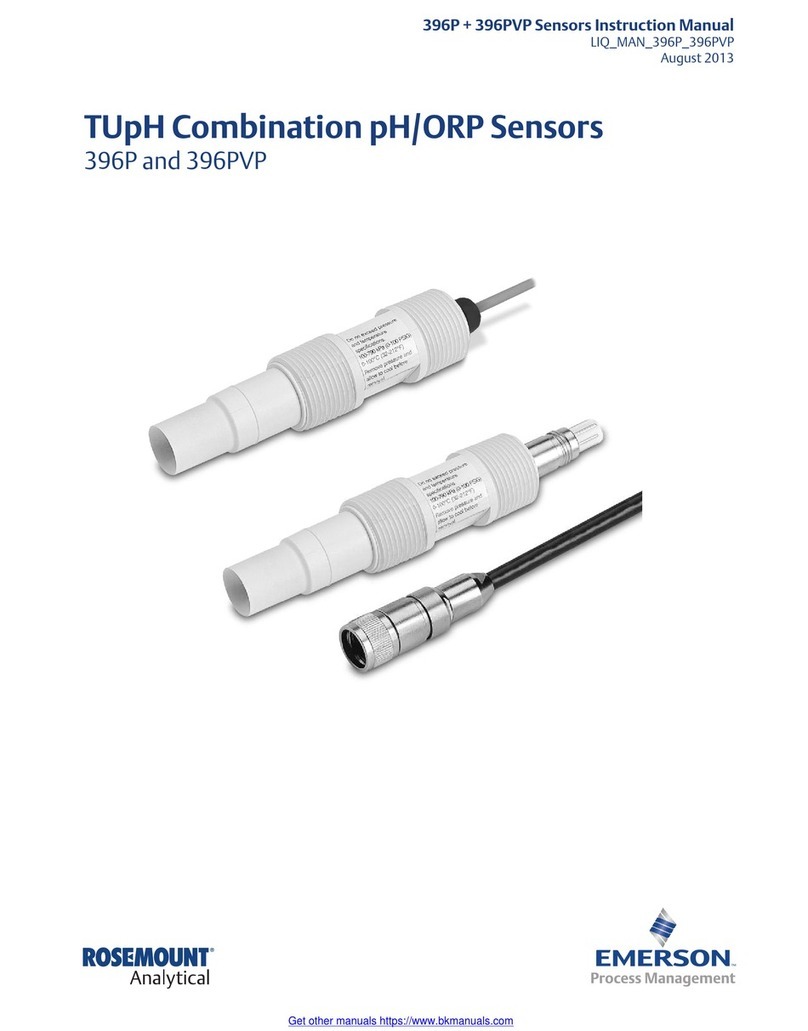
Emerson
Emerson Rosemount 396P instruction manual
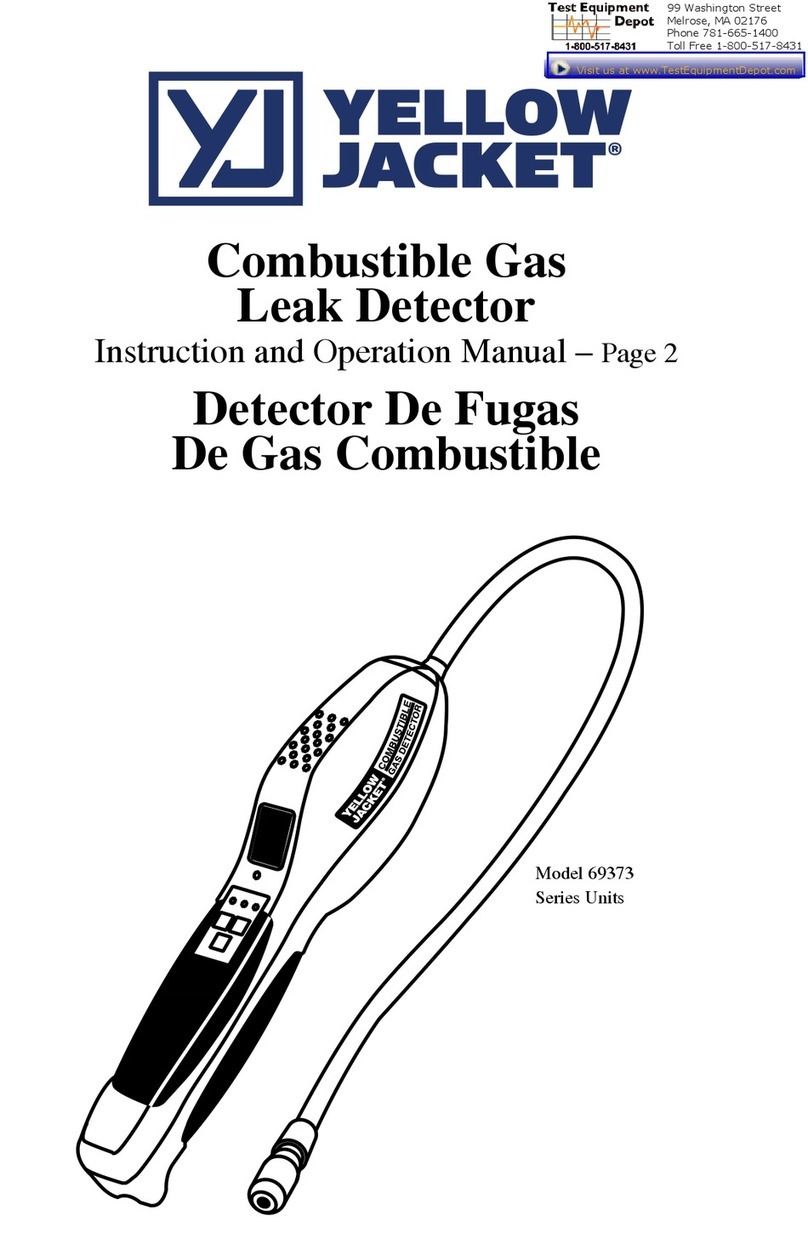
yellow jacket
yellow jacket 69373 Series Installation and operation manual
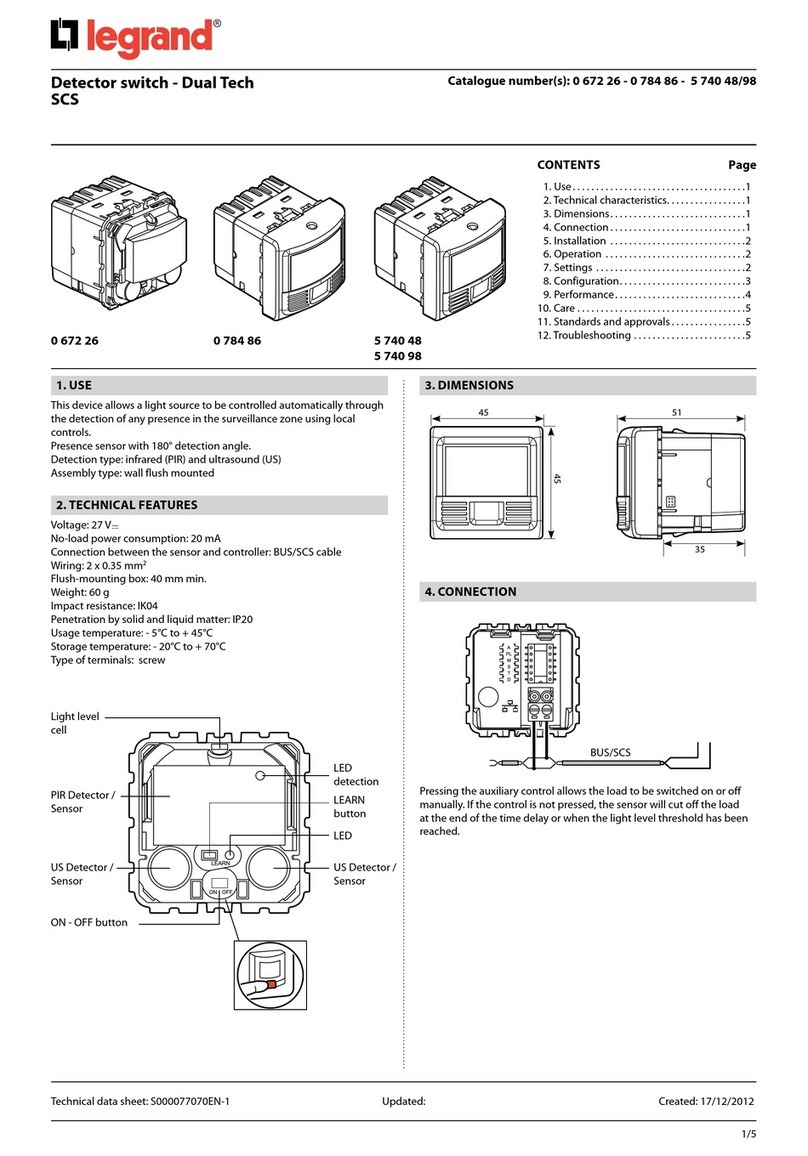
LEGRAND
LEGRAND 0 672 26 manual

SAL
SAL PIXIE MASTER SMS862WF/WH/BTAM quick start guide
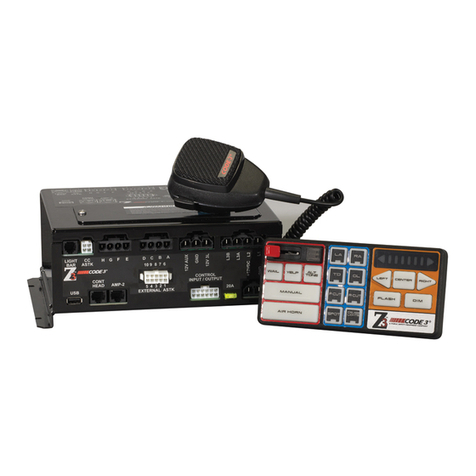
Code 3
Code 3 Z3 Series Installation & operation manual
